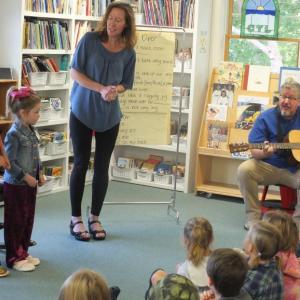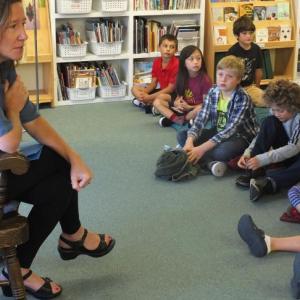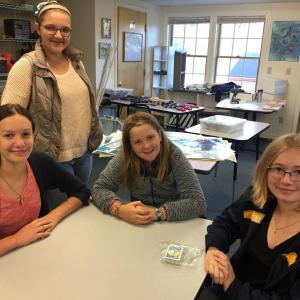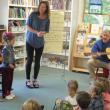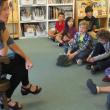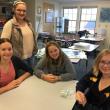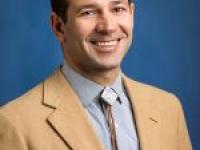Small Edgecomb school making big impact on global education
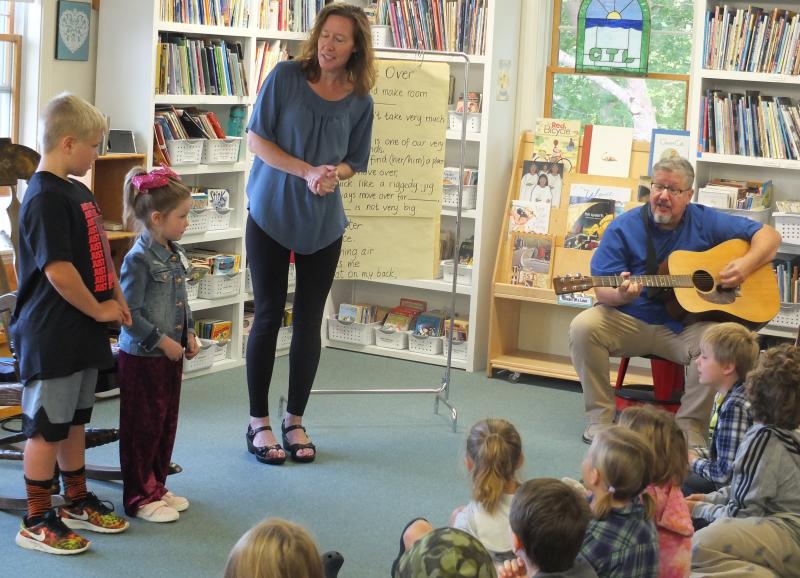 Teacher Jill Cotta introduces kindergartner Mariner Day to her fourth grade reading buddy Demetrius Hilgendorf during the Center for Teaching and Learning’s daily morning meeting. BILL PEARSON/Boothbay Register
Teacher Jill Cotta introduces kindergartner Mariner Day to her fourth grade reading buddy Demetrius Hilgendorf during the Center for Teaching and Learning’s daily morning meeting. BILL PEARSON/Boothbay Register
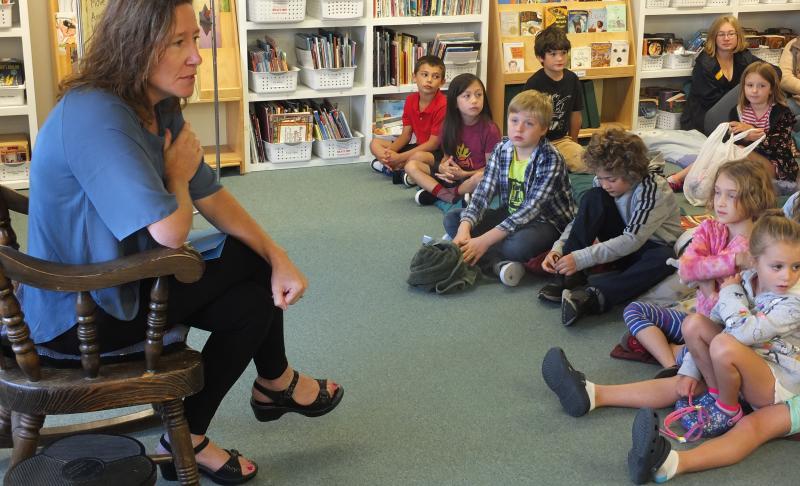 Third and fourth grade teacher Jill Cotta is in the rocking chair leading morning meeting, a daily ritual at the private demonstration school in Edgecomb. BILL PEARSON/Boothbay Register
Third and fourth grade teacher Jill Cotta is in the rocking chair leading morning meeting, a daily ritual at the private demonstration school in Edgecomb. BILL PEARSON/Boothbay Register
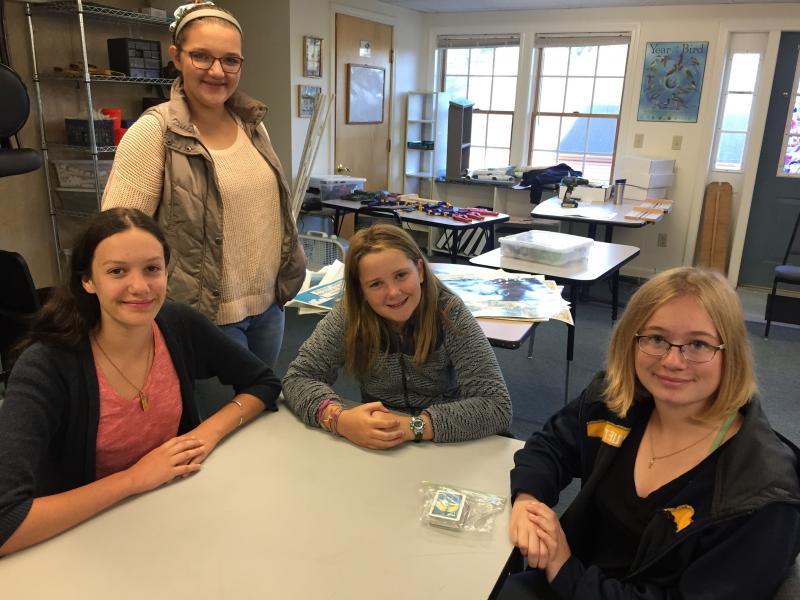 Center for Teaching and Learning students, from left, Ruth Burchsted, Emma Abbott, Kestrel Linehan and Aeila Russell, all enjoy the school’s writing program. BILL PEARSON/Boothbay Register
Center for Teaching and Learning students, from left, Ruth Burchsted, Emma Abbott, Kestrel Linehan and Aeila Russell, all enjoy the school’s writing program. BILL PEARSON/Boothbay Register
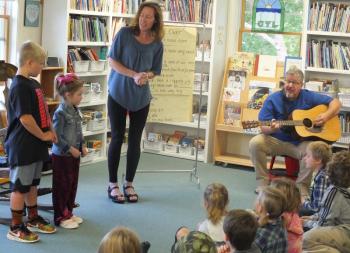 Teacher Jill Cotta introduces kindergartner Mariner Day to her fourth grade reading buddy Demetrius Hilgendorf during the Center for Teaching and Learning’s daily morning meeting. BILL PEARSON/Boothbay Register
Teacher Jill Cotta introduces kindergartner Mariner Day to her fourth grade reading buddy Demetrius Hilgendorf during the Center for Teaching and Learning’s daily morning meeting. BILL PEARSON/Boothbay Register
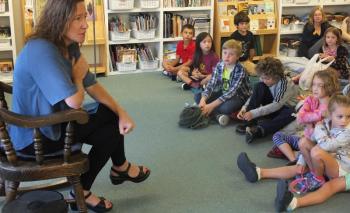 Third and fourth grade teacher Jill Cotta is in the rocking chair leading morning meeting, a daily ritual at the private demonstration school in Edgecomb. BILL PEARSON/Boothbay Register
Third and fourth grade teacher Jill Cotta is in the rocking chair leading morning meeting, a daily ritual at the private demonstration school in Edgecomb. BILL PEARSON/Boothbay Register
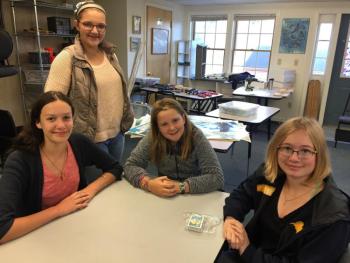 Center for Teaching and Learning students, from left, Ruth Burchsted, Emma Abbott, Kestrel Linehan and Aeila Russell, all enjoy the school’s writing program. BILL PEARSON/Boothbay Register
Center for Teaching and Learning students, from left, Ruth Burchsted, Emma Abbott, Kestrel Linehan and Aeila Russell, all enjoy the school’s writing program. BILL PEARSON/Boothbay Register
Sept. 6 was a pretty big day for kindergartner Mariner Day. Not only was she serenaded by the Center for Teaching and Learning’s entire student body with three separate versions of “Happy Birthday,” she also met Demetrius Hilgendorf, her fourth grade reading buddy for the school year.
The meeting occurred during morning meeting, a staple of the private kindergarten through grade eight, Edgecomb school since it began 29 years ago. Morning meeting is where students and staff congregate at 8:30 a.m. for daily announcements. All 65 students sit on pillows on the floor as a teacher sits in a rocking chair leading the meeting. It may be a teacher announcing something school-related or a student reporting seeing an animal. “We sing songs and students may recite poems,” said Head of School Katy Inman. “We all start the day together which makes everybody feel welcome and connected. It’s really one of the best parts of the school.”
And it seems the school’s approach to educating elementary students works. Morning meeting isn’t the only unique approach used by the private demonstration school. Students call teachers by their first name, each classroom is filled with large volumes of books, and most of all, there is an emphasis on the workshop approach to teaching.
The workshop approach is the main tenet founder Nancie Atwell instilled in the school. For nearly three decades, Atwell taught seventh- and eighth-grade reading and writing in public schools. Atwell was teaching at Boothbay Region Elementary School when she discovered the workshop approach being advocated by University of New Hampshire instructor Donald Graves. From there, she wrote ”In the Middle,” a book based on the workshop approach. The research-based method explains how a teacher and student learning together is an effective teaching tool. The book sold 500,000 copies and led to Atwell leaving teaching to accept public speaking engagements across the country.
Shortly afterwards, Atwell missed teaching, and wanted to see if the workshop method worked in the classroom. In 1990, she founded the Center for Teaching and Learning to put the principles to work. “I wanted to teach kids and teachers at the same time, so we made it a demonstration school,” she said. “Teachers come from all over the country and world to spend a week at the school. They see the workshop in action and we call them interns.”
The workshop creates an opportunity for students to do self-discovery and requires them to take a more active part in their learning, according to Inman. A main component is breaking down barriers between individuals. This is why students call teachers by their first names. Inman said this places teachers and students on the same level, more like a peer or mentor.
“It’s important to bring down those barriers. In this school, everybody teaches, and everybody learns,” Inman said.
The workshop approach empowers students to take charge of their learning. Students are given more autonomy and choice in their studies, leading to greater investigation of topics, according to first and second grade teacher Ted DeMille. He taught in the Cape Elizabeth school system before arriving in Edgecomb 21 years ago. He came to CTL wanting to learn more about the workshop approach. Another workshop component is having students lead classroom lessons by showing how they discovered a solution to a problem.
In the workshop, a lesson may begin with a teacher presenting a mini-lesson, and a student will eventually complete it. “Kids love to learn from someone a head taller than them. Peers sometimes act as mentors, and explain how they learned something which triggers something in another student. It is far more effective than hearing it from me,” DeMille said.
DeMille isn’t the only experienced teacher drawn to CTL. The school’s reputation is a beacon for quality teachers from across America to teach at a small Maine private school. For Inman, the school’s and Atwell’s reputation was why she left her job as a Massachusetts middle school director of reading and writing to work at the school. She first heard about Atwell as an undergraduate student. She described Atwell’s impact on education as “groundbreaking” and jumped at the opportunity to work in her school. “It’s kind of legendary here. This is a place known by teachers. I came here because it’s one of the best schools in the country, and I wanted my children to have an opportunity to attend school here.”
With Atwell’s experience as a language arts teacher, it isn’t surprising her school is known for producing outstanding writers. Students will read as many as 40 books during the school year. CTL students have also received many state and national awards and accolades for writing. “The teaching begins in kindergarten with the basics,” DeMille said. “We teach the various elements of setting, plot and characters, but we don’t give them a strong prompt. They can write about anything.”
Student writers share their work with their peers and outside audiences. The school enters their works in various competitions, which staff and administrators believe strengthen their students’ writing and editing skills. “Our school has received a lot of recognition for writing,” Inman said. “What our emphasis on reading and writing does is make for great communicators which is a skill set important in any field.”
The school’s approach to writing is popular with its students. Eighth grader Aelia Russell of East Boothbay has attended CTL since the third grade. She is considering a career in education or journalism. “I love writing. We have an amazing amount of time to write and revise our stories,” she said. “I’ve realized what a powerful tool it is, and I know it will benefit me whether I go into teaching or as a senior White House correspondent.”
Parents are also big fans of the school. Christine Selman of Boothbay sends both of her children there. The family moved here six years ago when her daughter Serafina was 2. Selman heard how the school fostered “a wonderful community feeling,” which prompted her to consider sending her daughter to CTL. “We decided to explore our options at the school’s open house and saw how comfortable and at ease students are to opening up and meeting people,” she said. “Our kids really love it there, and they get kind of sad when it’s time for winter or summer break.”
But the school isn’t for everyone. For parents looking for a school with a grading system or that does well on national standardized tests, CTL isn’t for them. Student progress isn’t judged on grades or test scores. The reason for this is Atwell doesn’t believe standardize tests tell much about the learning process. “If it helped direct instruction that would be another thing, but it doesn’t. They don’t measure real learning and aren’t productive, at all.”
The school has a capacity of 75 students. There is an admissions process where the staff and administration review whether or not the school would be a good fit for the parent and student. The school is divided into trimesters. So three times per year parents are required to spend an hour going over their child’s portfolio to gauge learning progress. “We require a lot from the parents, like taking time to review what their child learned. Also, we are as apt to contact them when their child did something right, as when they did something wrong,” she said.
A major difference between CTL and local public schools is CTL has no services for special needs students. The school charges $9,600 per year which isn’t enough to provide specialized services, according to Inman. Public schools are required by law to provide education to special needs students.
“The school is not for everyone. If a student needs a speech pathologist we can’t provide that service. I love public schools, and I have no problem paying taxes because they do such a fantastic job,” Inman said.
In 2015, Atwell received the inaugural Global Teacher Prize for work in elementary school education and a $1 million prize. She plans on using the prize money to expand the school library and provide financial assistance to needy families to maintain diversity within the student body.
And in the school’s three decades, Atwell said not much has really changed. “I’d describe it as True North. Yes, there has been some tinkering around the edges, but basically the principles have stayed the same. The same research-based methods are used for making students real writers, real mathematicians and real scientists and historians.”
Event Date
Address
United States

